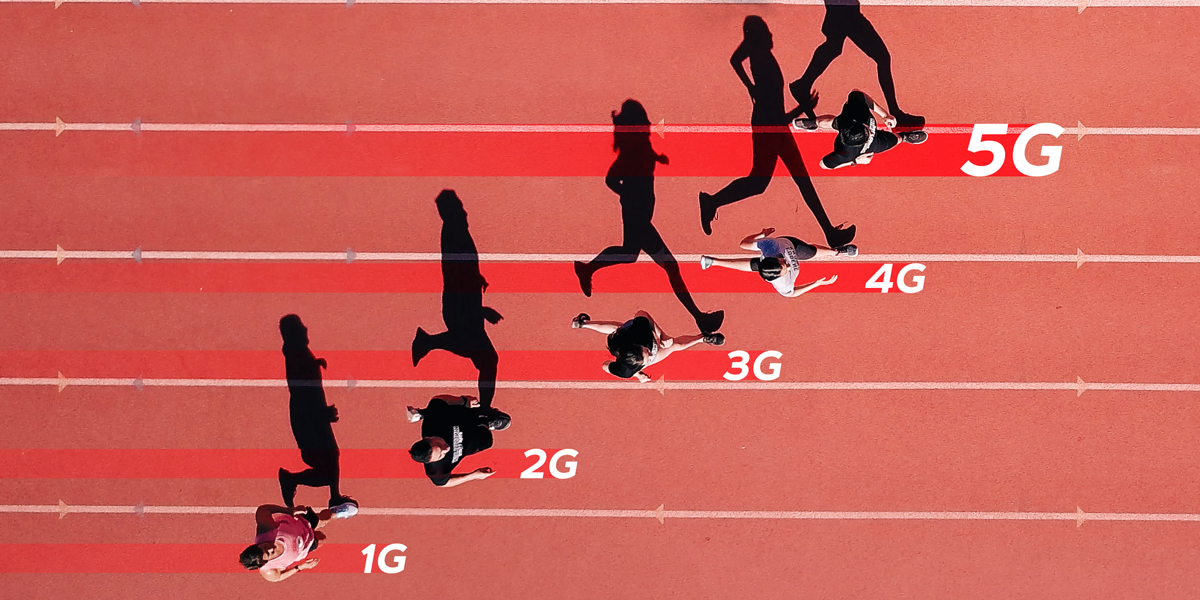Product request
You are looking for a solution:
Select an option, and we will develop the best offer
for you
How 5G networks can transform IPTV/OTT

The 5G technology has been drawing increased interest over the past few years, with experts talking about the new opportunities the technology opens. What users want to know though is whether it is safe. Let's take a closer look at the impact 5G will have on the IPTV/OTT industry.
What is 5G?
5G is an abbreviated name of the fifth-generation mobile communications (5 + G as in generation), a new global wireless communication standard developed after the 1G, 2G, 3G, and 4G networks.
In contrast to 4G, which uses frequencies from 0.4 GHz to 3.2 GHz, 5G raises the upper end of the band to 300 GHz. As a result, the technology provides higher peak data transfer speeds (up to a few Gbps), ultra-low latency, and high connection reliability. Apart from high-speed data transfers, 5G enables control of drone-type devices and machinery.
The wide frequency band lets one select a data transmission method that is the most convenient and suitable for a given situation. Long-distance data transfers use low frequencies. Although connection speeds stay low, the walls and other obstacles don't dampen the signal. To transfer large amounts of data fast, one needs to use high radio frequencies. The throughput of such networks exceeds that of 4G by orders of magnitude.
5G is already used in applications calling for high data transfer rates, e.g., mobile communications, cloud services, Smart Home technology, autopiloted transport, and online gaming. The USA, South Korea, China, and other countries are already introducing the technology. According to Gizchina.com, almost 30% of mobile subscribers globally will transition to 5G by 2025. | .png) |
Advantages of 5G over previous generations
Here is a brief overview of the previous generations of wireless communication technologies.
1G: analog communication. Although produced as early as 1973, the first cell phones didn't hit the shelves and become a consumer device until 11 years later. These devices could only convey speech and otherwise were just regular wireless telephones transmitting the analog signal over radio waves. In the 1980s, mobile communication standards differed between countries and there was no seamless network coverage as we know it.
The 1G communication was slow, unstable, prone to signal distortion, devoid of encryption or any other protection, and prohibitively expensive.
2G: digital mobile communication + SMS. In 1991, networks carrying digital signals first appeared. Mobile communication became more affordable, too. GSM was introduced as a unified standard in Europe, and D-AMPS in the USA. The advent of 2G enhanced the user experience with the short message service (SMS), roaming, and Internet access via the WAP protocol. Voice conversations became encrypted, and packet data transfers were introduced. Also, data rates increased compared to 1G.
3G: fast communication + video. In the early 2000s, digital communication rose to a new level with the emergence of Wideband Code Division Multiple Access. Subscribers used the entire frequency band available to the network. Each of them also got a personal digital code to encode and decode their signal. 3G featured improved connection fault protection while on the move as well as higher data transfer speeds. Users finally could watch online video on their devices and make video calls.
4G: broadband telecommunications. In 2008, mobile communication technology went a step further. New communication standards stipulated a data rate of 1 Gbps for pedestrians and stationary subscribers and up to 100 Mbps for those moving inside vehicles.

5G: minimum latency + high speed. The first commercial 5G mobile networks were deployed in 2018. This standard will change all aspects of our lives. Let's touch on 5G's principal advantages.
- Ultra-low latency
- With 5G, the time it takes to get data onto the device shrank to a minimum. The average latency went down from about 50 ms on 4G networks to a mere 1 ms, which is unnoticeable to the human eye.
- Radio technology
- 5G needs no cables or wires to transfer data — the signal is carried over radio waves emitted by small antennas.
- Wide frequency band
- While 4G networks occupied the frequency band of 0.4–3.2 GHz, 5G extends it all the way to 300 GHz. The number of data transfer channels has thus substantially increased and download/upload speeds have become much faster.
- Larger carrying capacity
- 4G networks could handle up to 100,000 devices per 1 km2. The fifth-generation mobile communication standard raises this bar tenfold.
- High data rates
- 5G networks provide data rates massively higher than the previous-generation ones.
4G | 5G | |
Average rate | 10 MB/s | 50 MB/s |
Maximum rate | up to 1 GB/s | 1–10 GB/s |
HD film download time | Several minutes | Several seconds |
Availability of 5G networks
The numbers of 5G network users keep growing. In Q2 2020, there were 137 million of them. By February 2021, the figure had risen to 200 million.
Compatible subscriber equipment and network coverage are needed to use 5G networks. The first 5G networks and the devices supporting this standard date back to 2017. Now the range of 5G devices is much broader, as is their availability.
5G coverage is limited for now: the technology has been deployed most broadly in the USA, Western Europe, Southeast Asia, and Western Asia. Still, 5G is quickly gaining traction globally. You can find out if 5G is available in your region from the Ookla 5G Map. Its developers are updating the data weekly.

Why 5G broadcast is the future of television
Earth's population is growing rapidly. UN forecasts that there will be 11.2 billion people living on the planet by 2100 (currently 7.8 billion). The number of mobile and Internet users will keep increasing accordingly, too. Current telecommunication standards will not suffice to ensure adequate quality of service for these users, while the 5G infrastructure has enough capacity to provide them with a high-quality Internet connection.
People increasingly consume videos online. Cable and terrestrial TV are losing ground: users want to choose content themselves and watch it whenever it is convenient to them. This is impossible with linear TV, which makes IPTV increasingly popular.
Video size is increasing. Technological advances have brought about new and ‘heavier’ formats — 4K and 8K. Such video occupies much more space on media, and it may take hours to transfer it over the existing networks. The new telecom standard enables the transmission of high-resolution content and stutter-free playback on consumer devices.
Old networks barely handle ever-increasing loads. Bearing in mind the dynamic described above, it's safe to say that current 4G networks will be unable to ensure the required data transfer rates in the near future. Their throughput is just too small. The existing data transfer format will need to be changed sooner or later. The 5G technology can become a solution to the problem of rising internet traffic.
What 5G changes for operators
The new standard will have an impact on IPTV/OTT industry, too, enabling operators to improve the quality of their services. The principal advantage of 5G is that it's a low-latency high-speed radio technology that can handle massively more devices, which opens a host of new opportunities for operators.
Demand for connected TV and OTT will rise. Increasingly more people prefer the wide range of IPTV/OTT content to scheduled TV shows and films. With 5G, they all will be able to connect to interactive television and watch exciting content with zero latency and in high quality.
Operators will not have to care about the network's throughput
Broadband Internet's capacity is a limitation to the operators. They have to compress hi-res video and balance network loads. The limitations are especially evident during the streaming of major sports events or other TV programs with many viewers. 5G will tackle this issue for operators, making the number of connected devices irrelevant.
More ad monetization opportunities
Owing to 5G's non-existing latency, advertisements can be run in real-time with instant feedback from users. Interactive advertising on the TV will become commonplace. It will motivate advertisers to become more active on IPTV/OTT services, boosting operators' revenue.
Get an in-depth look into ad monetization, choosing equipment for your service, content protection, and other aspects of building an IPTV/OTT-business with Infomir Academy. This unique project for new operators comprises a series of educational materials, in which Infomir's experts and active operators explain how to build an IPTV/OTT project from the ground up.

What 5G changes for users
Ultra HD content in the 5G IPTV environment will become more accessible. The new technology's primary advantage is that content can be enjoyed in high resolution not just at home but at any other place with Internet coverage, e.g., park, a café, or even while on the road. With 4G, the video stream could become unstable because of latency and video buffering. Fifth-generation mobile Internet's ultra-low latency and high data rates enable subscribers to watch HD and ever 4K content on their smartphones, tablets, and laptops.
No wires attached. Currently, subscriber devices rely on wired Internet connections. Even if the user's set-top box, laptop, or smartphone uses Wi-Fi, there is still a cable connected to the router.
5G will change it, enabling subscribers to ditch the cable in favor of truly wireless Internet access without sacrificing the connection speed. Connecting to IPTV/OTT services will become easier and user-friendly. Subscribers won't have to rack their brains over optimal routing for their cables and then drill into walls to do it.
5G users will thus enjoy all the advantages of broadband and wireless Internet combined. Subscribers will get a reliable Internet connection to watch stutter-free hi-res content and will be able to place their devices wherever they look best in the room, not being held back by cumbersome wires.
Will 5G affect smart televisions?
Experts forecast other 5G-capable devices will appear soon in addition to smartphones, e.g., set-top boxes, routers, and even Smart TVs.
Current Smart TVs connect to the Internet via an Ethernet cable or Wi-Fi, while the ones using the fifth-generation telecom standard will probably have 5G modems, SIM card slots, and associated software in them. To connect a device like this to the Internet, one will only need to find a mobile carrier with 5G support. TVs lacking 5G support will have to be connected to a wireless router via Wi-Fi.
The introduction of 5G in IPTV/OTT will open new opportunities for operators, e.g., easy hi-res video streaming to wireless devices like smartphones, laptops, and tablets. And high data transfer rates will ensure that playback stays smooth and disruption-free. The quality of live streams will increase, too. With all that, operators will be able to provide higher-quality services and thereby boost their revenue.
Recommended

How Local Operators Compete with Global Streaming Platforms
Just ten years ago, the video content market was relatively predictable: satellite and cable TV dominated, and users rarely thought about subscription-based consumption.

How to Measure the Effectiveness of IPTV Platform Promotion Without Access to User Data
In an era of stricter privacy regulations and growing limitations on collecting personal information, IPTV operators and distributors face a new challenge

IPTV and Advertising: Formats, Technologies, and Monetization Strategies for Operators
In the era of personalized consumption and digital transformation, advertising in IPTV has evolved from a possible option to a crucial revenue stream.










